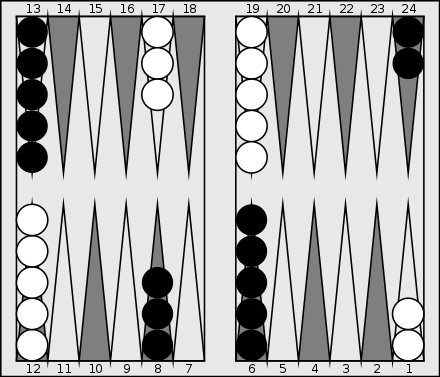
Backgammon is one of the oldest known board games. Its history can be traced back nearly 5,000 years to archeological discoveries in Mesopotamia. It is a two-player game where each player has fifteen pieces that move between twenty-four triangles (points) according to the roll of two dice. The objective of the game is to be first to bear off, i.e. move all fifteen checkers off the board. Backgammon is a member of the tables family, one of the oldest classes of board games.

Craps is a dice game in which the players make wagers on the outcome of the roll, or a series of rolls, of a pair of dice. Players may wager money against each other or a bank. Because it requires little equipment, "street craps" can be played in informal settings. While shooting craps, players may use slang terminology to place bets and actions.
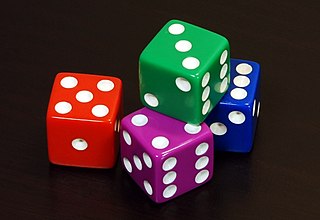
Dice are small, throwable objects with marked sides that can rest in multiple positions. They are used for generating random numbers, commonly as part of tabletop games, including dice games, board games, role-playing games, and games of chance.

Draughts or checkers is a group of strategy board games for two players which involve diagonal moves of uniform game pieces and mandatory captures by jumping over opponent pieces. Draughts developed from alquerque. The name derives from the verb to draw or to move.
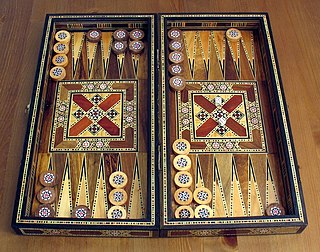
Tables is a general name given to a class of board games similar to backgammon, played on a board with two rows of 12 vertical markings called "points". Players roll dice to determine the movement of pieces. Tables games are among the oldest known board games, and many variants are played throughout the world.

Tabula, meaning a plank or board, was a Greco-Roman board game, and is generally thought to be the direct ancestor of modern backgammon.

The Royal Game of Ur, also known as the Game of Twenty Squares or simply the Game of Ur, is a two-player strategy race board game that was first played in ancient Mesopotamia during the early third millennium BC. The game was popular across the Middle East among people of all social strata and boards for playing it have been found at locations as far away from Mesopotamia as Crete and Sri Lanka. At the height of its popularity, the game acquired spiritual significance, and events in the game were believed to reflect a player's future and convey messages from deities or other supernatural beings. The Game of Ur remained popular until late antiquity, when it stopped being played, possibly evolving into, or being displaced by, an early form of backgammon. It was eventually forgotten everywhere except among the Jewish population of the Indian city of Kochi, who continued playing a version of it until the 1950s when they began emigrating to Israel.
Hypergammon is a variant of backgammon.

Acey-deucey is a variant of backgammon. Since World War I, it has been a favorite game of the United States Navy, Marine Corps, and Merchant Marine. Some evidence shows that it was played in the early 1900s aboard U.S. Navy ships. The game is believed to be rooted in the Middle East, Greece, or Turkey, where there were variants in which the game started with pieces off the board.
Comprehensive School Mathematics Program (CSMP) stands for both the name of a curriculum and the name of the project that was responsible for developing curriculum materials in the United States.

English draughts or checkers, also called American checkers or straight checkers, is a form of the strategy board game draughts. It is played on an 8×8 chequered board with 12 pieces per side. The pieces move and capture diagonally forward, until they reach the opposite end of the board, when they are crowned and can thereafter move and capture both backward and forward.

Gul bara is a backgammon variant. It is also called as ‘Rosespring Backgammon’ or ‘Crazy Narde’. The motive of the game is to move all of one's checkers around the board and bear them off. The first player who bears off all his/her checkers wins the game. The game is popular in Bulgaria, Azerbaijan, Greece, Turkey and North Macedonia.
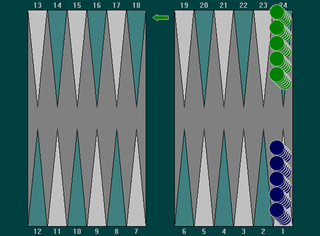
Plakotó (Πλακωτό) is a tables game popular in Greece. The object of Plakotó is for the player to bring all their checkers around to their own home board and then bear them off. The player who bears off all of his checkers first wins the game. This game is usually played along with two other variants, Févga and Pórtes. Together these three games are called Távli, and are played in sequence usually one after the other. They have matches of three, five or seven points. A Bulgarian version of Plakoto is known as Tapa. And also as Tsillitón(Τσιλλιτόν), in Cyprus.

Paul David Magriel Jr. was an American professional backgammon player, poker player, and author based in Las Vegas, Nevada.
Tapa (Тапа) is a version of Backgammon played in Bulgaria and North Macedonia. It is also played in Greece, where it is known as Plakoto. The word tapa means bottle cap.
The first moves of a backgammon game are the opening moves, collectively referred to as the opening, and studied in the backgammon opening theory. Backgammon opening theory is not developed in as much detail as opening theory in chess, which has been widely studied. The reason for this is that following the first move in backgammon, there are 21 dice roll outcomes on each subsequent move, and many alternative plays for each outcome, making the tree of possible positions in backgammon expand much more rapidly than in chess.
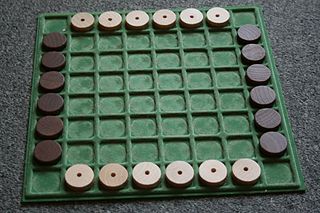
Lines of Action is an abstract strategy board game for two players invented by Claude Soucie. The objective is to connect all of one's pieces into a single group.
TD-Gammon is a computer backgammon program developed in 1992 by Gerald Tesauro at IBM's Thomas J. Watson Research Center. Its name comes from the fact that it is an artificial neural net trained by a form of temporal-difference learning, specifically TD-lambda.
Sho is a traditional race game in Tibet. Its name is simply the Tibetan word for "dice". It is traditionally played for money and by men, with two to four players - three being the most common. With four players, the usual variant is to play as two teams of two, with the partners sitting opposite each other.
In backgammon, there are a number of strategies that are distinct to match play as opposed to money play. These differences are most apparent when a player is within a few points of winning the match.
